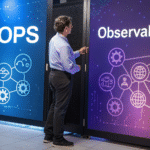AI and the Future of Holograms in Digital Innovation

The digital world is undergoing rapid transformations, and AI-generated holograms are leading the charge. These holograms are changing how we interact with technology, blurring the lines between physical and virtual spaces. AI-driven systems now create stunning 3D images and interactive experiences that were once unimaginable.

What Is AI Generated Holograms?
AI generated holograms are 3D projections created by using artificial intelligence to enhance the visual and interactive aspects of the display. Unlike traditional 3D graphics, holograms provide a more lifelike, immersive experience that appears to float in mid-air. AI makes it possible to generate these holograms quickly and accurately, adapting them to user interactions and the environment around them.
How do they work?
- AI Algorithms: Machine learning models (e.g., deep learning, neural networks) analyze data (like 2D images or videos) to predict depth, simulate light interactions, and construct 3D representations.
- Computational Efficiency: AI accelerates complex calculations needed for realistic holograms, making them faster to produce than through traditional methods.
Technologies Involved
- Deep Learning: Trains models to infer 3D structures from 2D inputs.
- Generative AI: Creates entirely new holographic content (e.g., using GANs or diffusion models).
Applications
- Entertainment: Immersive concerts, gaming, and holographic displays.
- Healthcare: 3D medical imaging for surgery or diagnostics.
- Education: Interactive 3D models for training.
- Telecommunications: Holographic video calls.
Benefits
- Speed: Real-time hologram generation.
- Adaptability: Customizable for different devices (AR/VR, holographic projectors).
- Accessibility: Reduces reliance on specialized hardware.
Challenges
- Computational Demands: Requires significant processing power.
- Ethical Concerns: Potential misuse (deep fakes, misinformation).
Benefits of AI Generated Holograms in Digital Innovation
- Immersive Experiences: AI generated holograms provide an immersive, lifelike experience. Whether for entertainment, education, or marketing, users feel as though they are part of the scene, creating unforgettable interactions.
- Enhanced Communication In business, holograms offer an innovative way to communicate with customers and clients. Virtual meetings with AI generated holograms allow for more personalized, effective engagement.
- Improved Learning and Training Holographic visuals create a more interactive and engaging learning method. Medical students, engineers, and other professionals can use holograms to simulate real-world scenarios for training, improving skills, and knowledge retention.
- Cost-Effective Advertising: For businesses, AI generated holograms are a unique and cost-effective way to advertise products or services. Their high engagement rates make them ideal for attracting and holding the attention of customers.
- Real-Time Customization: AI’s ability to learn and adapt makes holograms customizable in real time. As a user interacts with a hologram, it can change dynamically based on inputs, providing a personalized experience that traditional media cannot replicate.
- Data Visualization In fields like data science and analytics, AI generated holograms enable professionals to visualize complex data sets in 3D, helping to simplify and understand large amounts of information quickly.
- Future of Entertainment: The entertainment industry is already embracing AI generated holograms for concerts, events, and movies. Artists can appear as holograms on stage, and audiences can interact with their favorite characters in immersive, new ways.

Pros and Cons of AI Generated Holograms
- Engagement: Holograms grab attention like no other medium.
- Innovation: Microsoft offers cutting-edge solutions for businesses and industries.
- Versatility: It can be used in a wide range of fields, from education to entertainment.
- Personalization: AI allows holograms to adapt to user needs in real time.
- Efficiency: It saves time and resources compared to traditional 3D modeling.
- High Initial Costs: Setting up holographic technology can be expensive.
- Technical Complexity: Requires specialized equipment and knowledge to create and display holograms.
- Limited Accessibility: Current hologram tech may not be widely available to all users.
- Energy Consumption: Some hologram displays consume more power than traditional screens.
How AI Generated Holograms Will Shape the Future
As AI continues to advance, the potential for holographic technology will only expand. The fusion of AI and holograms promises to improve how we experience virtual environments, making them more lifelike, interactive, and accessible. Holograms will likely become a common feature in industries such as retail, healthcare, entertainment, and education.
In the future, AI generated holograms could replace traditional screen-based interfaces, creating a world where digital information is projected directly into our environments. Think of virtual meetings where holograms of people appear in your living room or medical procedures being conducted with holographic guidance.
Hologram Technology in the Future
Hologram technology is rapidly evolving, offering a glimpse into a future where physical and digital worlds seamlessly merge. While we’ve seen early applications of holograms in entertainment and advertising, the technology is set to revolutionize many industries. The future of holograms promises advancements that could completely change how we interact with technology, business, and everyday life.
The Role of Hologram Technology in the Future
In the coming years, holograms will become an integral part of the digital experience. With advancements in AI, 3D imaging, and interactive displays, holograms will no longer be limited to sci-fi movies. They will become commonplace in education, healthcare, business, and entertainment.
- Virtual Meetings and Remote Work
Holograms will reshape the way we work. Shortly, you might attend a virtual meeting where your colleague appears as a hologram in your office space, providing a more personal and interactive experience than video calls. This technology will improve communication, making remote work feel more like an in-person collaboration. - Education and Training
Education will be transformed with hologram technology. Teachers could use 3D projections to bring subjects to life, allowing students to explore complex concepts like anatomy or historical events in an interactive, hands-on way. In fields like medicine, engineering, and even space exploration, holograms will offer immersive training experiences, enabling professionals to simulate real-world situations for practice. - Healthcare Advancements
Holograms could play a key role in healthcare, from improving diagnostics to assisting in surgeries. Doctors could use 3D holographic images to better visualize organs and structures, leading to more accurate diagnoses and treatment planning. In surgery, holograms could assist by providing real-time visualizations of a patient’s body, guiding surgeons to perform precise procedures. - Entertainment and Live Events
The entertainment industry will also benefit from hologram technology. Imagine concerts where your favorite artist is projected as a hologram, performing live on stage even if they’re thousands of miles away. Movies and video games will become more immersive with holographic characters and environments that you can interact with in real time. - Retail and Marketing
In retail, holograms could offer new ways for customers to interact with products. For example, instead of browsing a website or looking at a product in-store, customers could view a hologram of a product, try it virtually, and even get personalized recommendations. This could revolutionize how we shop and increase customer engagement in stores. - Data Visualization and Analysis
Holograms will change how we visualize and interact with data. Complex datasets could be displayed in 3D, allowing analysts to manipulate and explore data from every angle. This will make it easier to identify trends, patterns, and insights, leading to more informed decision-making across industries.
Key Benefits of Hologram Technology in the Future
- Enhanced Interactivity: Holograms will create more interactive experiences that are tailored to the user, offering personalized content and dynamic responses based on real-time input.
- Immersion: The lifelike, three-dimensional nature of holograms will immerse users in their environment, improving experiences in education, gaming, and virtual tourism.
- Collaboration: In the workplace, holograms will enable better collaboration across distances, bringing teams together in a virtual space where they can interact as though they were physically present.
- Efficiency: With holographic technology, complex information can be visualized and understood more easily, improving workflows and decision-making in industries like healthcare, business, and research.
Challenges and Considerations
Despite the exciting potential, there are still challenges that must be addressed:
- Cost: Advanced holographic technology is expensive, and widespread adoption will require significant investment in both hardware and software.
- Accessibility: For holograms to become a part of everyday life, technology must be made more accessible to the general public. This includes reducing the cost of holographic displays and improving the user-friendliness of the technology.
- Infrastructure: Holograms require a high-performance computing infrastructure and advanced data transmission capabilities. As demand grows, there will be a need for robust networks that can support real-time, high-resolution holographic data.
- Privacy and Security: As holograms become more integrated into our personal lives and businesses, protecting sensitive data displayed in 3D form will become a critical concern.
The Future of Hologram Technology
Looking ahead, the future of hologram technology is bright. With ongoing advancements in AI, 3D imaging, and computing, holograms will become more realistic, interactive, and accessible. The boundaries between the digital and physical worlds will continue to blur, creating new possibilities for entertainment, education, business, healthcare, and much more.
We are on the brink of a revolution in how we interact with technology. Holograms could change the way we work, learn, play, and even live—ushering in an era of immersive, interactive experiences that bring the world to life like never before.

Conclusion: AI and the Future of Holograms in Digital Innovation
AI and holograms working together will likely change how we use tech in the future. AI can make holograms quicker, smarter, and easier to build. Holograms can make digital stuff feel more real, like you’re there. This mix could help doctors plan surgeries better, let students learn with 3D models they can “touch,” or make concerts feel like you’re right in the crowd.
As it improves, everyday things—like video calls, shopping, or games—could feel more lifelike and fun. We’ll need to keep things safe and fair, but if done right, this tech could bring people closer, inspire cool ideas, and fix problems in new ways. The future looks bright, with endless possibilities we’re just starting to dream up!
Frequently Asked Questions (FAQ)
What is AI generated holograms?
AI generated holograms are 3D visual projections created using artificial intelligence to enhance their interactivity and realism. These holograms appear to float in mid-air, offering an immersive and lifelike experience.
How do AI generated holograms work?
AI algorithms process real-time data and adapt holographic displays based on user interaction, making them highly customizable and interactive. The AI technology ensures that the holograms respond intelligently to different inputs.
What are the main benefits of AI generated holograms?
The key benefits include immersive experiences, enhanced communication, real-time customization, cost-effective advertising, and improved learning and training opportunities.
Are AI generated holograms only for entertainment?
No, AI generated holograms can be used in various sectors, including healthcare, education, business communication, data visualization, and advertising, making them versatile tools for multiple industries.
Can AI generated holograms replace traditional screens?
While it may take time, AI generated holograms could eventually replace traditional screens in many applications, offering more interactive and immersive digital experiences.
What is the future of AI generated holograms?
The future of AI generated holograms is bright, with technology expected to evolve into a more widely accessible and affordable medium. It could revolutionize fields like virtual meetings, entertainment, education, and interactive marketing.
Are there any downsides to using AI generated holograms?
Some downsides include high initial setup costs, the technical complexity of creating holograms, and the energy consumption of holographic displays. Access to this technology is also currently limited.

Nusrat Jahan
Nusrat Jahan is a content writer and copywriter at AI Sparkify, skilled in SEO, blogs, UX, email copy, and trained by Asia's Best IT Creative Institute.



